Tetranuclear Copper(I) and Silver(I) Pyrazolate Adducts with 1,1′-Dimethyl-2,2’-bibenzimidazole: Influence of Structure on Photophysics
Abstract
:1. Introduction
2. Results and Discussions
2.1. Synthesis
2.2. Crystal Structures
2.3. Photophysical Properties
3. Materials and Methods
3.1. Physical Measurement and Instrumentation
3.2. Crystal Structure Determination
3.3. Computational Details
3.4. Synthesis and Characterization
4. Conclusions
Supplementary Materials
Author Contributions
Funding
Institutional Review Board Statement
Informed Consent Statement
Data Availability Statement
Acknowledgments
Conflicts of Interest
Sample Availability
References
- Housecroft, C.E.; Constable, E.C. TADF: Enabling luminescent copper(i) coordination compounds for light-emitting electrochemical cells. J. Mater. Chem. C. 2022, 10, 4456–4482. [Google Scholar] [CrossRef] [PubMed]
- Zhang, W.; Ye, G.; Liao, D.; Chen, X.; Lu, C.; Nezamzadeh-Ejhieh, A.; Khan, M.S.; Liu, J.; Pan, Y.; Dai, Z. Recent Advances of Silver-Based Coordination Polymers on Antibacterial Applications. Molecules 2022, 27, 7166. [Google Scholar] [CrossRef]
- Zhang, X.; Chen, Z.; Liu, X.; Hanna, S.L.; Wang, X.; Taheri-Ledari, R.; Maleki, A.; Li, P.; Farha, O.K. A historical overview of the activation and porosity of metal-organic frameworks. Chem. Soc. Rev. 2020, 49, 7406–7427. [Google Scholar] [CrossRef] [PubMed]
- Thorarinsdottir, A.E.; Harris, T.D. Metal-Organic Framework Magnets. Chem. Rev. 2020, 120, 8716–8789. [Google Scholar] [CrossRef]
- Zhao, D.; Yu, S.; Jiang, W.-J.; Cai, Z.-H.; Li, D.-L.; Liu, Y.-L.; Chen, Z.-Z. Recent Progress in Metal-Organic Framework Based Fluorescent Sensors for Hazardous Materials Detection. Molecules 2022, 27, 2226. [Google Scholar] [CrossRef]
- Wallesch, M.; Volz, D.; Zink, D.M.; Schepers, U.; Nieger, M.; Baumann, T.; Brase, S. Bright coppertunities: Multinuclear Cu(I) complexes with N-P ligands and their applications. Chem. Eur. J. 2014, 20, 6578–6590. [Google Scholar] [CrossRef]
- El Sayed Moussa, M.; Evariste, S.; Wong, H.-L.; Le Bras, L.; Roiland, C.; Le Polles, L.; Le Guennic, B.; Costuas, K.; Yam, V.W.-W.; Lescop, C. A solid state highly emissive Cu(I) metallacycle: Promotion of cuprophilic interactions at the excited states. Chem. Commun. 2016, 52, 11370–11373. [Google Scholar] [CrossRef] [PubMed]
- Liu, W.; Zhu, K.; Teat, S.J.; Dey, G.; Shen, Z.; Wang, L.; O’Carroll, D.M.; Li, J. All-in-One: Achieving Robust, Strongly Luminescent and Highly Dispersible Hybrid Materials by Combining Ionic and Coordinate Bonds in Molecular Crystals. J. Am. Chem. Soc. 2017, 139, 9281–9290. [Google Scholar] [CrossRef]
- Artem’ev, A.V.; Doronina, E.P.; Rakhmanova, M.I.; Tarasova, O.A.; Bagryanskaya, I.Y.; Nedolya, N.A. Chemoselective mechanochemical route toward a bright TADF-emitting CuI-based coordination polymer. Inorg. Chem. Front. 2019, 6, 671–679. [Google Scholar] [CrossRef]
- Baranov, A.Y.; Pritchina, E.A.; Berezin, A.S.; Samsonenko, D.G.; Fedin, V.P.; Belogorlova, N.A.; Gritsan, N.P.; Artem’ev, A.V. Beyond Classical Coordination Chemistry: The First Case of a Triply Bridging Phosphine Ligand. Angew. Chem. Int. Ed. 2021, 60, 12577–12584. [Google Scholar] [CrossRef]
- Rogovoy, M.I.; Berezin, A.S.; Samsonenko, D.G.; Artem’ev, A.V. Silver(I)—Organic Frameworks Showing Remarkable Thermo-, Solvato- And Vapochromic Phosphorescence As Well As Reversible Solvent-Driven 3D-to-0D Transformations. Inorg. Chem. 2021, 60, 6680–6687. [Google Scholar] [CrossRef] [PubMed]
- Demyanov, Y.V.; Sadykov, E.H.; Rakhmanova, M.I.; Novikov, A.S.; Bagryanskaya, I.Y.; Artem’ev, A.V. Tris(2-Pyridyl)Arsine as a New Platform for Design of Luminescent Cu(I) and Ag(I) Complexes. Molecules 2022, 27, 6059. [Google Scholar] [CrossRef]
- Yersin, H.; Czerwieniec, R.; Monkowius, U.; Ramazanov, R.; Valiev, R.; Shafikov, M.Z.; Kwok, W.-M.; Ma, C. Intersystem crossing, phosphorescence, and spin-orbit coupling. Two contrasting Cu(I)-TADF dimers investigated by milli- to micro-second phosphorescence, femto-second fluorescence, and theoretical calculations. Coord. Chem. Rev. 2023, 478, 214975. [Google Scholar] [CrossRef]
- Mohamed, A.A. Advances in the coordination chemistry of nitrogen ligand complexes of coinage metals. Coord. Chem. Rev. 2010, 254, 1918–1947. [Google Scholar] [CrossRef]
- Titov, A.A.; Filippov, O.A.; Epstein, L.M.; Belkova, N.V.; Shubina, E.S. Macrocyclic copper(I) and silver(I) pyrazolates: Principles of supramolecular assemblies with Lewis bases. Inorg. Chim. Acta 2018, 470, 22–35. [Google Scholar] [CrossRef]
- Brown, A.W. Chapter Two—Recent Developments in the Chemistry of Pyrazoles. In Advances in Heterocyclic Chemistry; Scriven, E.F.V., Ramsden, C.A., Eds.; Academic Press: Cambridge, MA, USA, 2018; Volume 126, pp. 55–107. [Google Scholar]
- Pettinari, C.; Tăbăcaru, A.; Galli, S. Coordination polymers and metal–organic frameworks based on poly(pyrazole)-containing ligands. Coord. Chem. Rev. 2016, 307, 1–31. [Google Scholar] [CrossRef]
- Zhang, W.; Feng, X.; Zhou, Y.; Chen, J.-H.; Ng, S.W.; Yang, G. Investigation of Structural Transformation of a Chain-like Silver(I) Pyrazolate into a Triangular Isomer. Cryst. Growth Des. 2022, 22, 259–268. [Google Scholar] [CrossRef]
- Omary, M.A.; Rawashdeh-Omary, M.A.; Diyabalanage, H.V.K.; Dias, H.V.R. Blue phosphors of dinuclear and mononuclear copper(I) and silver(I) complexes of 3,5-bis(trifluoromethyl)pyrazolate and the related bis(pyrazolyl)borate. Inorg. Chem. 2003, 42, 8612–8614. [Google Scholar] [CrossRef] [PubMed]
- Galassi, R.; Simon, O.C.; Burini, A.; Tosi, G.; Conti, C.; Graiff, C.; Martins, N.M.R.; Guedes da Silva, M.F.C.; Pombeiro, A.J.L.; Martins, L.M.D.R.S. Copper(I) and copper(II) metallacycles as catalysts for microwave assisted selective oxidation of cyclohexane. Polyhedron 2017, 134, 143–152. [Google Scholar] [CrossRef]
- Rasika Dias, H.V.R.; Polach, S.A.; Wang, Z. Coinage metal complexes of 3,5-bis(trifluoromethyl)pyrazolate ligand: Synthesis and characterization of {[3,5-(CF3)2Pz]Cu}3 and {[3,5-(CF3)2Pz]Ag}3. J. Fluor. Chem. 2000, 103, 163–169. [Google Scholar] [CrossRef]
- Omary, M.A.; Rawashdeh-Omary, M.A.; Gonser, M.W.A.; Elbjeirami, O.; Grimes, T.; Cundari, T.R.; Diyabalanage, H.V.K.; Gamage, C.S.P.; Dias, H.V.R. Metal Effect on the Supramolecular Structure, Photophysics, and Acid−Base Character of Trinuclear Pyrazolato Coinage Metal Complexes. Inorg. Chem. 2005, 44, 8200–8210. [Google Scholar] [CrossRef] [PubMed] [Green Version]
- Fujisawa, K.; Ishikawa, Y.; Miyashita, Y.; Okamoto, K.-I. Pyrazolate-bridged group 11 metal(I) complexes: Substituent effects on the supramolecular structures and physicochemical properties. Inorg. Chim. Acta 2010, 363, 2977–2989. [Google Scholar] [CrossRef]
- Watanabe, Y.; Washer, B.M.; Zeller, M.; Savikhin, S.; Slipchenko, L.V.; Wei, A. Copper(I)—Pyrazolate Complexes as Solid-State Phosphors: Deep-Blue Emission through a Remote Steric Effect. J. Am. Chem. Soc. 2022, 144, 10186–10192. [Google Scholar] [CrossRef]
- Zheng, J.; Yang, H.; Xie, M.; Li, D. The pi-acidity/basicity of cyclic trinuclear units (CTUs): From a theoretical perspective to potential applications. Chem. Commun. 2019, 55, 7134–7146. [Google Scholar] [CrossRef] [PubMed]
- Zhang, M.-M.; Dong, X.-Y.; Wang, Y.-J.; Zang, S.-Q.; Mak, T.C.W. Recent progress in functional atom-precise coinage metal clusters protected by alkynyl ligands. Coord. Chem. Rev. 2022, 453, 214315. [Google Scholar] [CrossRef]
- Lin, R.-B.; Liu, S.-Y.; Ye, J.-W.; Li, X.-Y.; Zhang, J.-P. Photoluminescent Metal-Organic Frameworks for Gas Sensing. Adv. Sci. 2016, 3, 1500434. [Google Scholar] [CrossRef]
- Parasar, D.; Ponduru, T.T.; Noonikara-Poyil, A.; Jayaratna, N.B.; Dias, H.V.R. Acetylene and terminal alkyne complexes of copper(i) supported by fluorinated pyrazolates: Syntheses, structures, and transformations. Dalton Trans. 2019, 48, 15782–15794. [Google Scholar] [CrossRef]
- Titov, A.A.; Larionov, V.A.; Smol’yakov, A.F.; Godovikova, M.I.; Titova, E.M.; Maleev, V.I.; Shubina, E.S. Interaction of a trinuclear copper(i) pyrazolate with alkynes and carbon-carbon triple bond activation. Chem. Commun. 2019, 55, 290–293. [Google Scholar] [CrossRef]
- Yang, L.; Wang, L.; Lv, X.; Chen, J.-H.; Wang, Y.; Yang, G. Complexation of triangular silver(I) or copper(I) nitropyrazolates with dibenzothiophenes having potential use in adsorptive desulfurization. Dalton Trans. 2021, 50, 2915–2927. [Google Scholar] [CrossRef]
- Zheng, J.; Wang, J.-N.; Wang, T.; Wu, K.; Wei, R.-J.; Lu, W.; Li, D. Phosphorescent Metal Rotaxane-like Bimetallic Ag/Au Clusters. J. Phys. Chem. C 2021, 125, 9400–9410. [Google Scholar] [CrossRef]
- Larionov, V.A.; Stashneva, A.R.; Titov, A.A.; Lisov, A.A.; Medvedev, M.G.; Smol’yakov, A.F.; Tsedilin, A.M.; Shubina, E.S.; Maleev, V.I. Mechanistic study in azide-alkyne cycloaddition (CuAAC) catalyzed by bifunctional trinuclear copper(I) pyrazolate complex: Shift in rate-determining step. J. Catal. 2020, 390, 37–45. [Google Scholar] [CrossRef]
- Titov, A.A.; Filippov, O.A.; Bilyachenko, A.N.; Smol’yakov, A.F.; Dolgushin, F.M.; Belsky, V.K.; Godovikov, I.A.; Epstein, L.M.; Shubina, E.S. Complexes of Trinuclear Macrocyclic Copper(I) and Silver(I) 3,5-Bis(Trifluoromethyl)Pyrazolates with Ketones. Eur. J. Inorg. Chem. 2012, 2012, 5554–5561. [Google Scholar] [CrossRef]
- Galassi, R.; Ricci, S.; Burini, A.; Macchioni, A.; Rocchigiani, L.; Marmottini, F.; Tekarli, S.M.; Nesterov, V.N.; Omary, M.A. Solventless Supramolecular Chemistry via Vapor Diffusion of Volatile Small Molecules upon a New Trinuclear Silver(I)-Nitrated Pyrazolate Macrometallocyclic Solid: An Experimental/Theoretical Investigation of the Dipole/Quadrupole Chemisorption Phenomena. Inorg. Chem. 2013, 52, 14124–14137. [Google Scholar] [CrossRef] [PubMed]
- Yang, G.; Baran, P.; Martínez, A.R.; Raptis, R.G. Substituent Effects on the Supramolecular Aggregation of AgI-Pyrazolato Trimers. Cryst. Growth Des. 2013, 13, 264–269. [Google Scholar] [CrossRef]
- Titov, A.A.; Guseva, E.A.; Filippov, O.A.; Babakhina, G.M.; Godovikov, I.A.; Belkova, N.V.; Epstein, L.M.; Shubina, E.S. The Role of Weak Interactions in Strong Intermolecular M···Cl Complexes of Coinage Metal Pyrazolates: Spectroscopic and DFT Study. J. Phys. Chem. A 2016, 120, 7030–7036. [Google Scholar] [CrossRef] [PubMed]
- Titov, A.A.; Filippov, O.A.; Guseva, E.A.; Smol’yakov, A.F.; Dolgushin, F.M.; Epstein, L.M.; Belsky, V.K.; Shubina, E.S. Role of basic sites of substituted ferrocenes in interaction with the trinuclear 3,5-bis(trifluoromethyl)pyrazolates: Thermodynamics and structure of complexes. RSC Adv. 2014, 4, 8350–8359. [Google Scholar] [CrossRef]
- Titov, A.A.; Smol’yakov, A.F.; Godovikov, I.A.; Chernyadyev, A.Y.; Molotkov, A.P.; Loginov, D.A.; Filippov, O.A.; Belkova, N.V.; Shubina, E.S. The role of weak intermolecular interactions in photophysical behavior of isocoumarins on the example of their interaction with cyclic trinuclear silver(I) pyrazolate. Inorg. Chim. Acta 2022, 539, 121004. [Google Scholar] [CrossRef]
- Titov, A.A.; Smol’yakov, A.F.; Baranova, K.F.; Filippov, O.A.; Shubina, E.S. Synthesis, structures and photophysical properties of phosphorus-containing silver 3,5-bis(trifluoromethyl)pyrazolates. Mendeleev Commun. 2018, 28, 387–389. [Google Scholar] [CrossRef]
- Dias, H.V.R.; Diyabalanage, H.; Jayaratna, N.B.; Shaw, D.; Hettiarachchi, C.V.; Parasar, D. Dinuclear and Trinuclear Complexes of Copper(I) and Silver(I) Supported by a Highly Fluorinated Pyrazolate [3,5-(CF3)2Pz]− and N-Heterocycles. Eur. J. Inorg. Chem. 2019, 2019, 3638–3644. [Google Scholar] [CrossRef]
- Titov, A.A.; Filippov, O.A.; Smol’yakov, A.F.; Baranova, K.F.; Titova, E.M.; Averin, A.A.; Shubina, E.S. Dinuclear CuI and AgI Pyrazolates Supported with Tertiary Phosphines: Synthesis, Structures, and Photophysical Properties. Eur. J. Inorg. Chem. 2019, 2019, 821–827. [Google Scholar] [CrossRef]
- Dias, H.V.R.; Palehepitiya Gamage, C.S.; Jayaratna, N.B.; Hettiarachchi, C.V. Mixed ligand complexes of silver(i) supported by highly fluorinated pyrazolates, and chelating and bridging N-heterocycles. New J. Chem. 2020, 44, 17079–17087. [Google Scholar] [CrossRef]
- Cui, Y.; Li, B.; He, H.; Zhou, W.; Chen, B.; Qian, G. Metal-Organic Frameworks as Platforms for Functional Materials. Acc Chem Res 2016, 49, 483–493. [Google Scholar] [CrossRef]
- Titov, A.A.; Smol’yakov, A.F.; Filippov, O.A. Heterobimetallic Silver(I) and Copper(I) pyrazolates supported with 1,1′-bis(diphenylphosphino)ferrocene. J. Organomet. Chem. 2021, 942, 121813. [Google Scholar] [CrossRef]
- Titov, A.A.; Filippov, O.A.; Smol’yakov, A.F.; Averin, A.A.; Shubina, E.S. Synthesis, structures and luminescence of multinuclear silver(i) pyrazolate adducts with 1,10-phenanthroline derivatives. Dalton Trans. 2019, 48, 8410–8417. [Google Scholar] [CrossRef]
- Emashova, S.K.; Titov, A.A.; Filippov, O.A.; Smol’yakov, A.F.; Titova, E.M.; Epstein, L.M.; Shubina, E.S. Luminescent AgI Complexes with 2,2′-Bipyridine Derivatives Featuring [Ag-(CF3)2Pyrazolate]4 Units. Eur. J. Inorg. Chem. 2019, 2019, 4855–4861. [Google Scholar] [CrossRef]
- Baranova, K.F.; Titov, A.A.; Smol’yakov, A.F.; Chernyadyev, A.Y.; Filippov, O.A.; Shubina, E.S. Mononuclear Copper(I) 3-(2-pyridyl)pyrazole Complexes: The Crucial Role of Phosphine on Photoluminescence. Molecules 2021, 26, 6869. [Google Scholar] [CrossRef]
- Huang, C.-H.; Yang, M.; Chen, X.-L.; Lu, C.-Z. Bright bluish-green emitting Cu(I) complexes exhibiting efficient thermally activated delayed fluorescence. Dalton Trans. 2021, 50, 5171–5176. [Google Scholar] [CrossRef] [PubMed]
- Lemos, S.S.; Deflon, V.M.; Bessler, K.E.; Abbott, M.P.; Niquet, E. Mononuclear and mixed-metal copper(I)-silver(I) complexes containing 2,2′-bibenzimidazole and triphenylphosphane as ligands: Crystal structures of [Cu(tmbbimH2)(PPh3)2](MeCOO)·0.2C7H8and [Ag0.55Cu1.45(μ-bbim)(PPh3)4]·4CH2Cl2. Trans. Met. Chem. 2004, 29, 46. [Google Scholar] [CrossRef]
- Walther, D.; Böttcher, L.; Blumhoff, J.; Schebesta, S.; Görls, H.; Schmuck, K.; Rau, S.; Rudolph, M. Tetranuclear Complexes Containing a Luminescent Ru2M2 Core [M = CuI, (allyl)PdII ]: Synthesis, Structures and Electrochemical Properties. Eur. J. Inorg. Chem. 2006, 2006, 2385–2392. [Google Scholar] [CrossRef]
- Frantz, D.K.; Sullivan, A.A.; Yasui, Y.; Linden, A.; Baldridge, K.K.; Siegel, J.S. Synthesis, X-ray crystal structures, and computational studies of 1,1′-bridged 4,4′-diaryl-2,2′-bibenzimidazoles: Building blocks for supramolecular structures. Org. Biomol. Chem. 2009, 7, 2347–2352. [Google Scholar] [CrossRef] [PubMed]
- Muller, E.; Bernardinelli, G.; Reedijk, J. 4,4′-Bis(2-picolinimino)-2,2′-bibenzimidazoles: A New Class of Dinucleating Ligands Which Allow for a Tuning of the Metal-Metal Distance. Structures and Properties of a Dicopper(II) Complex and of Two Oxygenation Products of a Dicopper(I) Complex; a Tentative Coordination Chemical Modeling of Hemocyanin. Inorg. Chem. 2002, 34, 5979–5988. [Google Scholar]
- Zhu, M.; Fujita, K.; Yamaguchi, R. Efficient synthesis of biazoles by aerobic oxidative homocoupling of azoles catalyzed by a copper(I)/2-pyridonate catalytic system. Chem. Commun. 2011, 47, 12876–12878. [Google Scholar] [CrossRef] [PubMed] [Green Version]
- Krishantha, D.M.M.; Gamage, C.S.P.; Schelly, Z.A.; Dias, H.V.R. Structures of Silver Pyrazolates in Hydrocarbon Solutions via Vapor-Pressure Osmometry. Inorg. Chem. 2008, 47, 7065–7067. [Google Scholar] [CrossRef]
- Emashova, S.K.; Titov, A.A.; Smol’yakov, A.F.; Chernyadyev, A.Y.; Godovikov, I.A.; Godovikova, M.I.; Dorovatovskii, P.V.; Korlykov, A.A.; Filippov, O.A.; Shubina, E.S. Emissive silver(i) cyclic trinuclear complexes with aromatic amine donor pyrazolate derivatives: Way to efficiency. Inorg. Chem. Front. 2022, 9, 5624–5634. [Google Scholar] [CrossRef]
- APEX II Software Version 2008.4.; Bruker AXS Inc.: Madison, WI, USA, 2008.
- Sheldrick, G.M. SHELXT—Integrated space-group and crystal-structure determination. Acta Cryst. Sect. A 2015, 71, 3–8. [Google Scholar] [CrossRef] [PubMed] [Green Version]
- Sheldrick, G.M. Crystal structure refinement with SHELXL. Acta Cryst. Sect. C 2015, 71, 3–8. [Google Scholar] [CrossRef] [Green Version]
- Dolomanov, O.V.; Bourhis, L.J.; Gildea, R.J.; Howard, J.A.K.; Puschmann, H. OLEX2: A complete structure solution, refinement and analysis program. J. Appl. Cryst. 2009, 42, 339–341. [Google Scholar] [CrossRef]
- Neese, F. The ORCA program system. WIREs Comput. Mol. Sci. 2011, 2, 73–78. [Google Scholar] [CrossRef]
- Neese, F. Software update: The ORCA program system, version 4.0. WIREs Comput. Mol. Sci. 2017, 8, e1327. [Google Scholar] [CrossRef]
- Lin, Y.-S.; Li, G.-D.; Mao, S.-P.; Chai, J.-D. Long-Range Corrected Hybrid Density Functionals with Improved Dispersion Corrections. J. Chem. Theory Comput. 2013, 9, 263–272. [Google Scholar] [CrossRef] [PubMed]
- Grimme, S.; Antony, J.; Ehrlich, S.; Krieg, H. A consistent and accurate ab initio parametrization of density functional dispersion correction (DFT-D) for the 94 elements H-Pu. J. Chem. Phys. 2010, 132, 154104. [Google Scholar] [CrossRef] [PubMed]
- Weigend, F.; Ahlrichs, R. Balanced basis sets of split valence, triple zeta valence and quadruple zeta valence quality for H to Rn: Design and assessment of accuracy. Phys. Chem. Chem. Phys. 2005, 7, 3297–3305. [Google Scholar] [CrossRef] [PubMed]
- Heß, B.A.; Marian, C.M.; Wahlgren, U.; Gropen, O. A mean-field spin-orbit method applicable to correlated wavefunctions. Chem. Phys. Lett. 1996, 251, 365–371. [Google Scholar] [CrossRef]
- De Souza, B.; Neese, F.; Izsak, R. On the theoretical prediction of fluorescence rates from first principles using the path integral approach. J. Chem. Phys. 2018, 148, 034104. [Google Scholar] [CrossRef]
- Lu, T.; Chen, F. Multiwfn: A multifunctional wavefunction analyzer. J. Comput. Chem. 2012, 33, 580–592. [Google Scholar] [CrossRef]

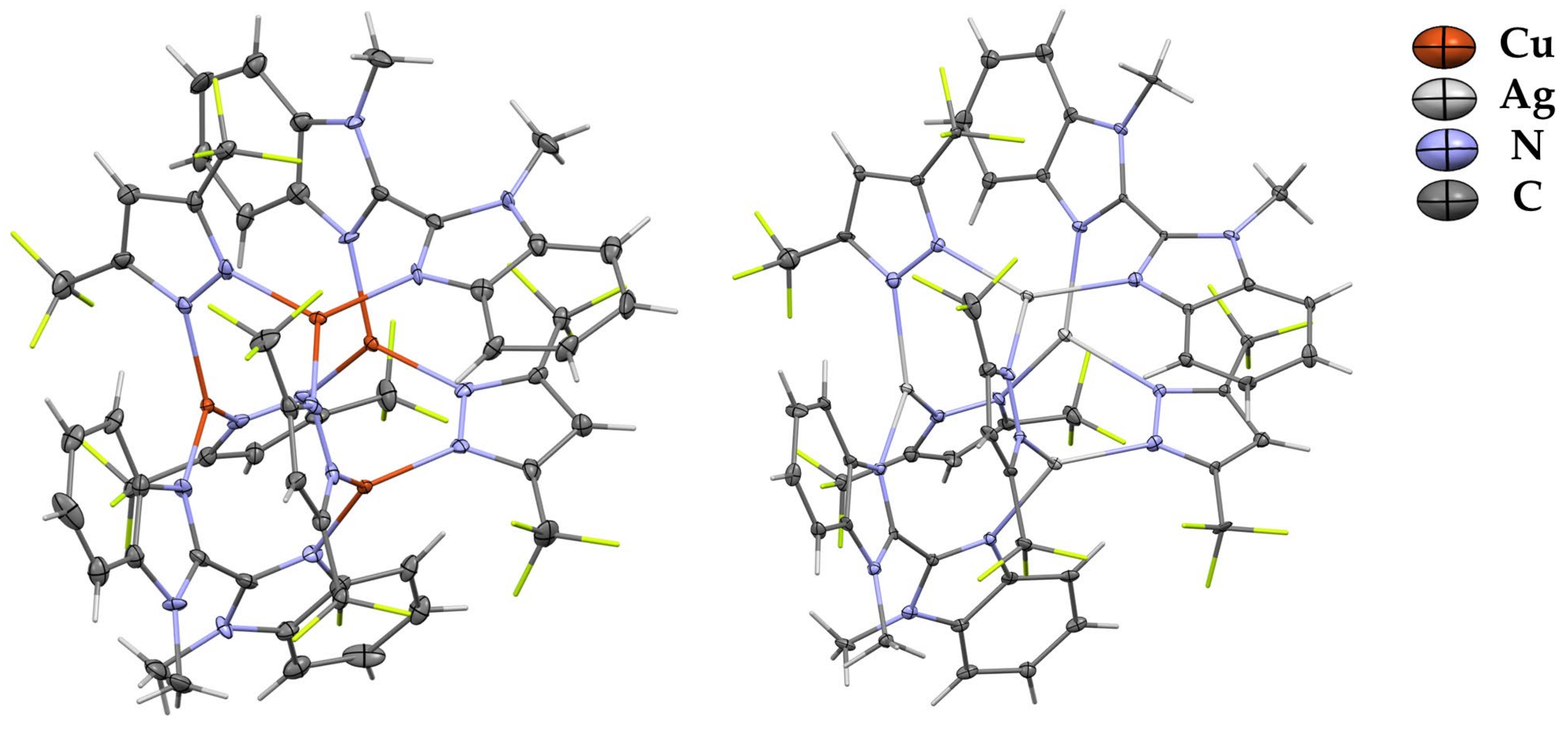
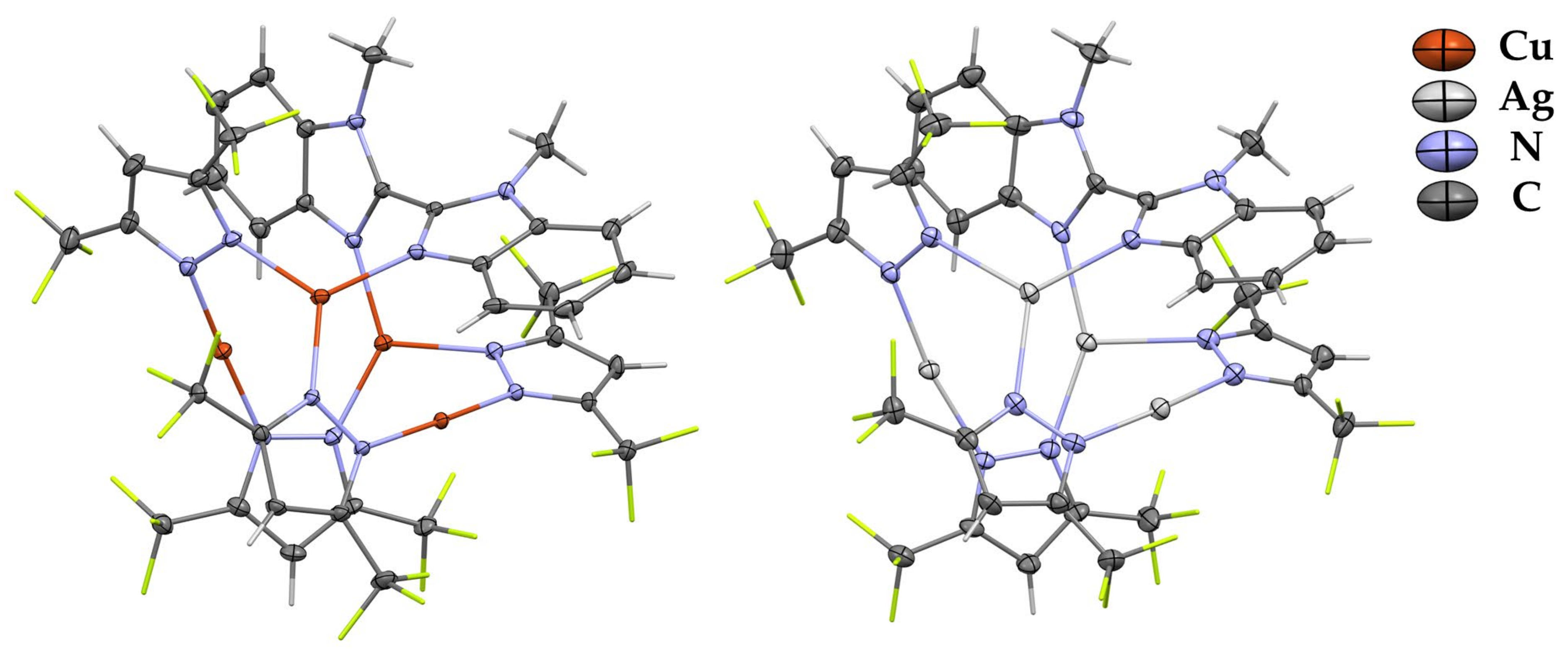



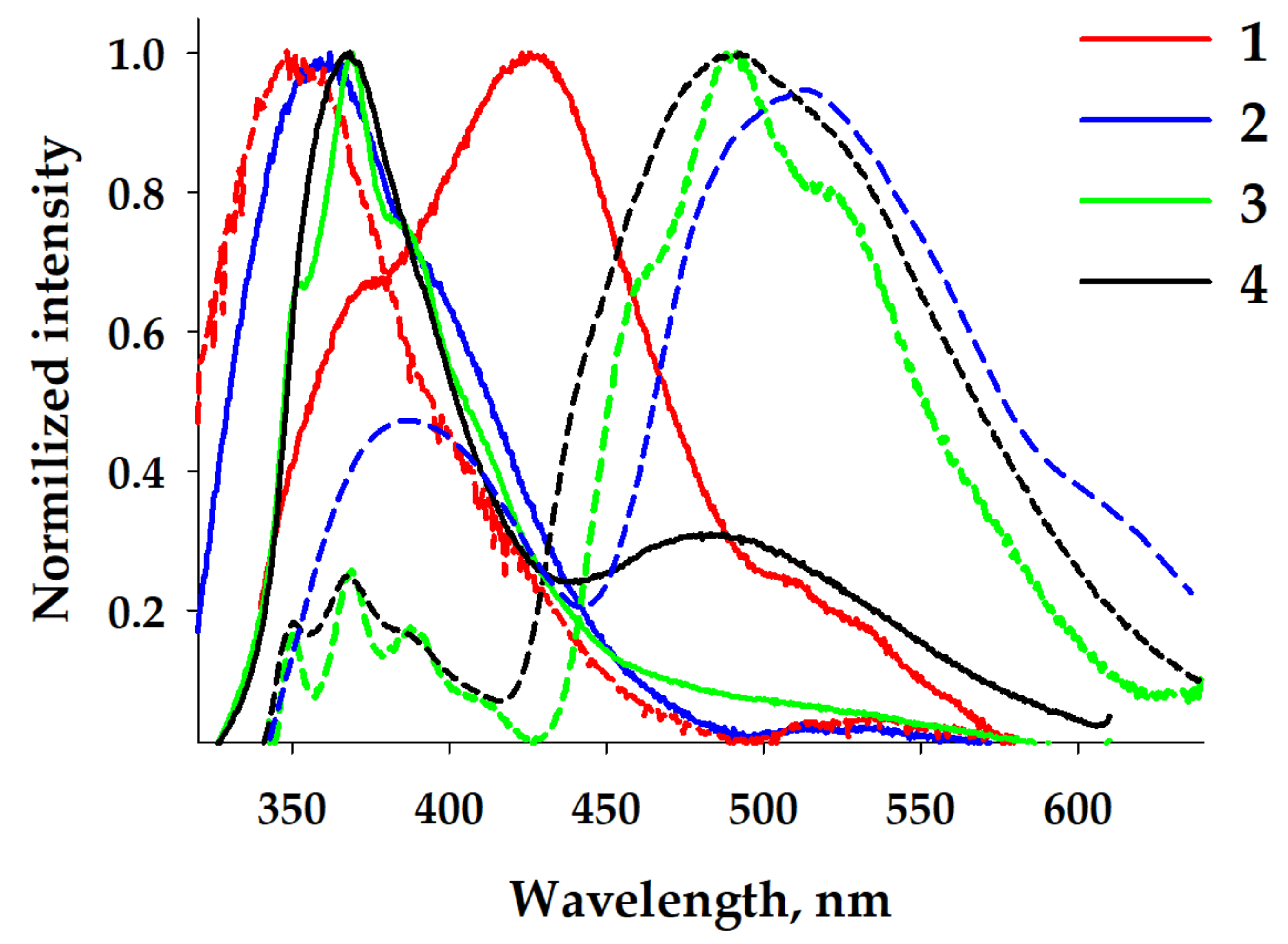
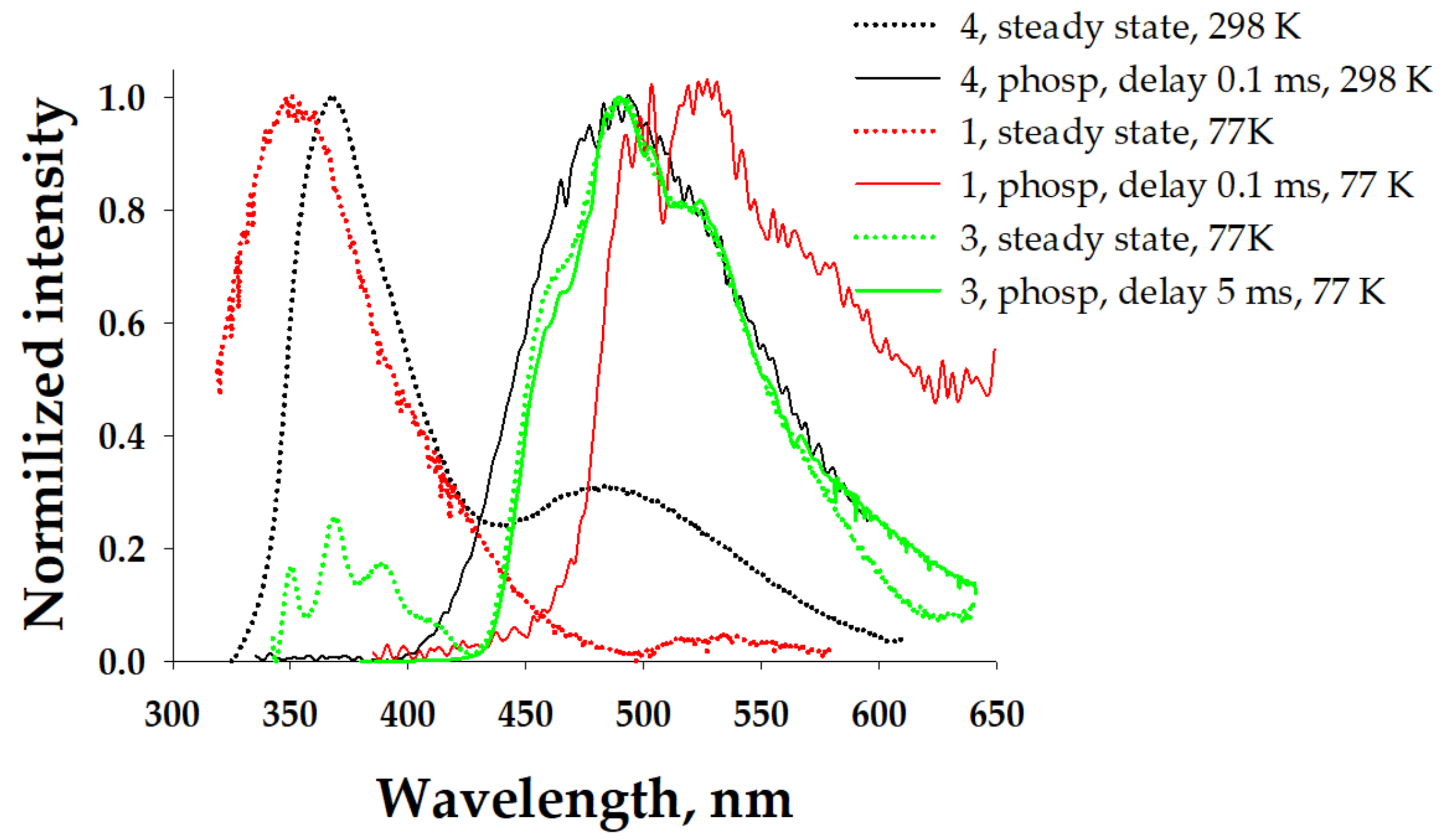

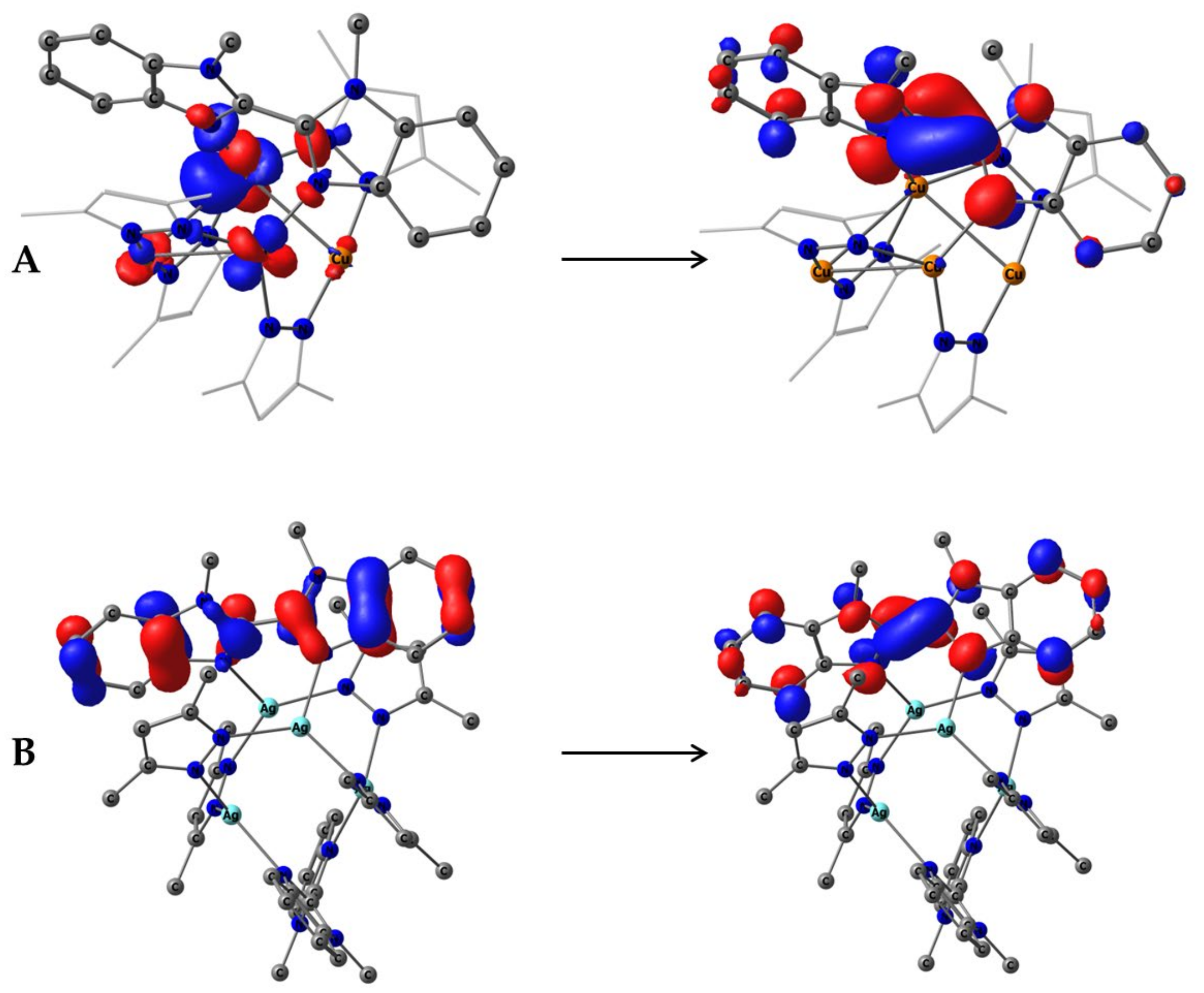
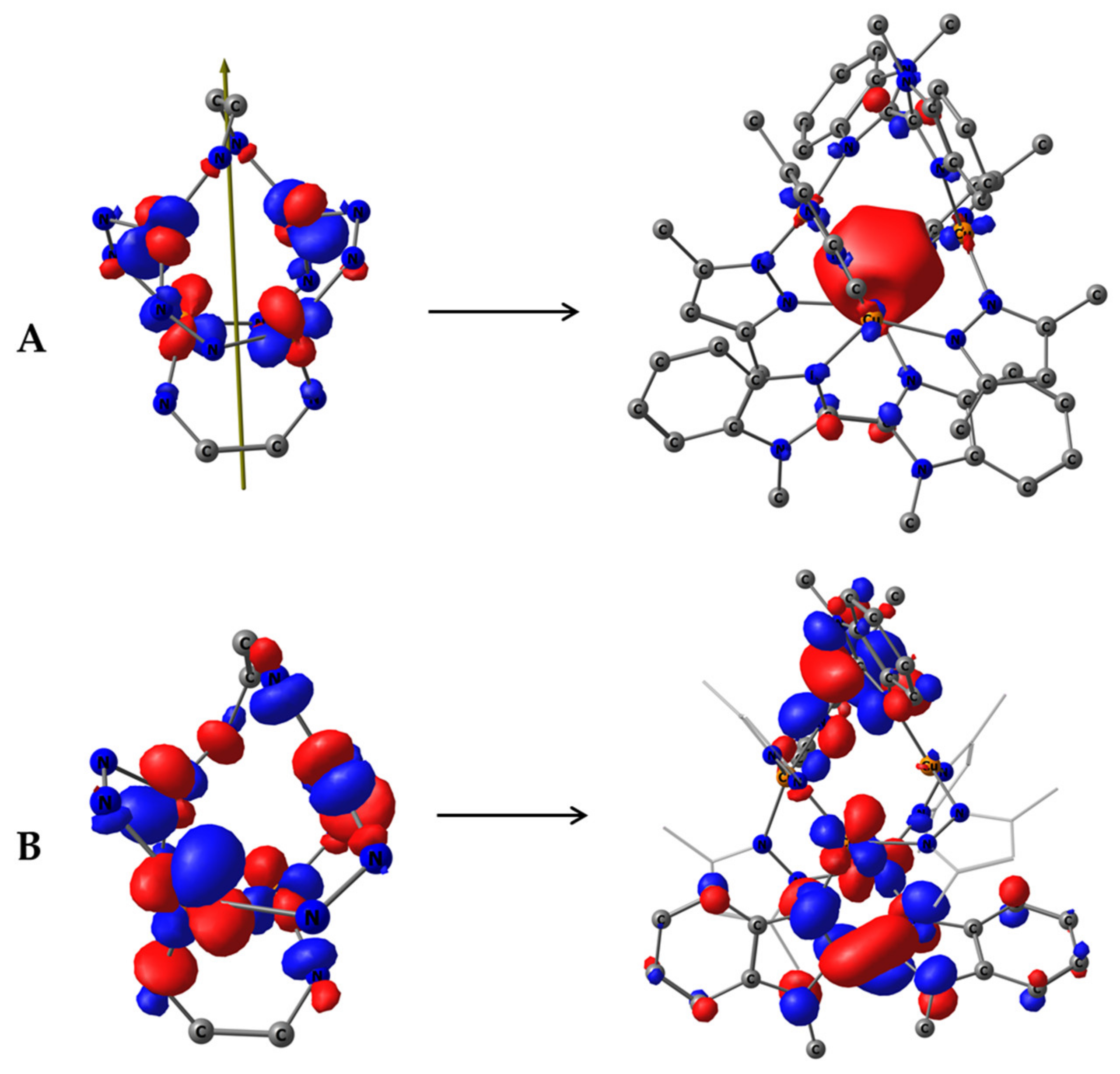
| Solution (c = 1.2 × 10−2 M) | Solid | |||||
|---|---|---|---|---|---|---|
| λmaxem, nm; a 298 K | λmaxem, nm; a 77 K | λmaxem, nm;a 298 K | τ298 (λmaxem = 497)a, ms | λmaxem, nm;a 77 K | τ77 (λmaxem = 505) a, ms | |
| 1 | 355, 369, 387, 410, 436 | 356, 376, 398, 413,418,c 530d | 380, 426, 525 (tail) | - | 350 c, 525 d (tail) | 0.063 ± 0.01; 0.066 ± 0.04; |
| 2 | 353, 371, 389, 410, 436 | 390 e, 530 d | 360, 400 (sh) b | - | 387 c, 510 d | 0.141 ± 0.001, 0.974 ± 0.016 |
| 3 | 353, 371, 389, 410, 436 | 358, 370, 378, 390, 400, c 470, 500, 535 d | 367, 395 (sh) | 0.523 ± 0.001 | 350, 367, 385 c, 463, 489, 520 d | 13.3 ± 0.1 |
| 4 | 353, 371, 389, 410, 436 | 353, 367, 373, 380, 390, c 490 d | 350, 367, 395 (sh) | - | 350, 367, 385, c 489, 520 d (sh) | 13.8 ± 0.1 |
Disclaimer/Publisher’s Note: The statements, opinions and data contained in all publications are solely those of the individual author(s) and contributor(s) and not of MDPI and/or the editor(s). MDPI and/or the editor(s) disclaim responsibility for any injury to people or property resulting from any ideas, methods, instructions or products referred to in the content. |
© 2023 by the authors. Licensee MDPI, Basel, Switzerland. This article is an open access article distributed under the terms and conditions of the Creative Commons Attribution (CC BY) license (https://creativecommons.org/licenses/by/4.0/).
Share and Cite
Yakovlev, G.B.; Titov, A.A.; Smol’yakov, A.F.; Chernyadyev, A.Y.; Filippov, O.A.; Shubina, E.S. Tetranuclear Copper(I) and Silver(I) Pyrazolate Adducts with 1,1′-Dimethyl-2,2’-bibenzimidazole: Influence of Structure on Photophysics. Molecules 2023, 28, 1189. https://doi.org/10.3390/molecules28031189
Yakovlev GB, Titov AA, Smol’yakov AF, Chernyadyev AY, Filippov OA, Shubina ES. Tetranuclear Copper(I) and Silver(I) Pyrazolate Adducts with 1,1′-Dimethyl-2,2’-bibenzimidazole: Influence of Structure on Photophysics. Molecules. 2023; 28(3):1189. https://doi.org/10.3390/molecules28031189
Chicago/Turabian StyleYakovlev, Gleb B., Aleksei A. Titov, Alexander F. Smol’yakov, Andrey Yu. Chernyadyev, Oleg A. Filippov, and Elena S. Shubina. 2023. "Tetranuclear Copper(I) and Silver(I) Pyrazolate Adducts with 1,1′-Dimethyl-2,2’-bibenzimidazole: Influence of Structure on Photophysics" Molecules 28, no. 3: 1189. https://doi.org/10.3390/molecules28031189
APA StyleYakovlev, G. B., Titov, A. A., Smol’yakov, A. F., Chernyadyev, A. Y., Filippov, O. A., & Shubina, E. S. (2023). Tetranuclear Copper(I) and Silver(I) Pyrazolate Adducts with 1,1′-Dimethyl-2,2’-bibenzimidazole: Influence of Structure on Photophysics. Molecules, 28(3), 1189. https://doi.org/10.3390/molecules28031189








